Disclosure: Meeple Mountain received a free copy of this product in exchange for an honest, unbiased review. This review is not intended to be an endorsement.
Vivid Memories — formerly known as Vivid — is the latest title to hit Kickstarter from Floodgate Games. With their great track record of producing fun, thinky games with beautiful components, it’s easy to expect another high-quality hit. Does Vivid Memories deliver? Read on to see what we think of this unique brain game.
Give Me a Moment
In Vivid Memories players will be collecting memory fragments, savoring formative moments, building connections between core memories, and otherwise trying to turn their childhood recollections into points. The player with the most points at the end of the game is the winner.
Each player receives a recessed Brain board, a Memory Bank board, and a hidden Aspiration that will earn the player extra points at game end for collecting a certain color of memory Fragments.
The Brain board is the nerve center of Vivid Memories. It features an arrangement of empty hexes to be filled with Fragments and an array of empty slots along the outer edge to represent Core Memories. Each of these slots has a color that matches a Fragment. A Core Memory may consist of 1, 2, or 3 such slots with an equivalent number of colors. While each player’s Brain will have different colors in each slot, the number and positioning of the Core Memories is identical on each board.
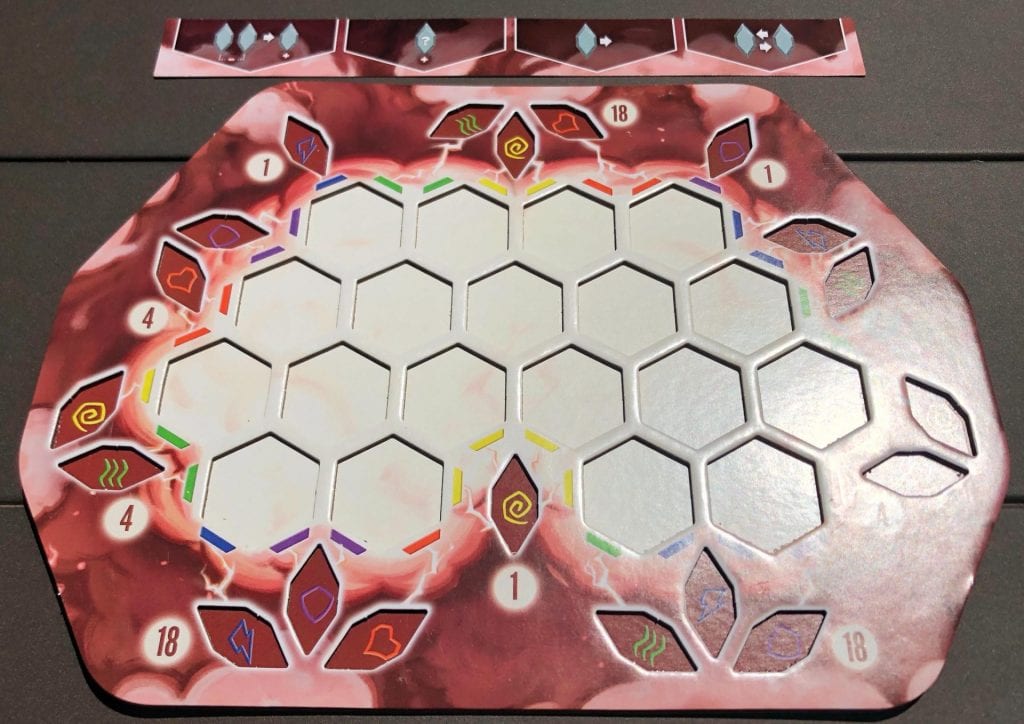
To start each of the game’s 3 rounds, a number of Moment tiles will be laid out in a row and covered with variously-colored Fragments according to player count. Players will take turns drafting 1, 2, or 3 fragments from these tiles and placing them into an empty hex space on their respective Brain board. There are some specific rules around drafting and it’s worth covering them all now:
- Fragments must always be taken from a tile at either end of the row, only moving onto the next tile in order once the endmost tile is emptied;
- If a player takes 1 Fragment, they may immediately take a Rewire action that (broadly) allows them to move multiple Fragments into or out of any single hex on their board;
- If a player takes 2 Fragments, they must be the same color;
- If a player takes 3 Fragments, they must all be different colors;
- If a player empties a Moment tile, they take that tile into their play area.

After all Fragments and Moment tiles have been claimed, players have a chance to simultaneously rework their board. First, they have to place as many of their claimed Moment tiles as they can manage onto the 4 action spaces of their Memory Bank board, discarding any they can’t fit. These tiles will cover up and replace the board’s default actions (for better or worse). Next, every player can take each available action on their board a single time. These actions allow players to manipulate the Fragments on their board in a variety of ways: adding, swapping, combining, etc. Since each action can only be taken once per round, players have to pick wisely.
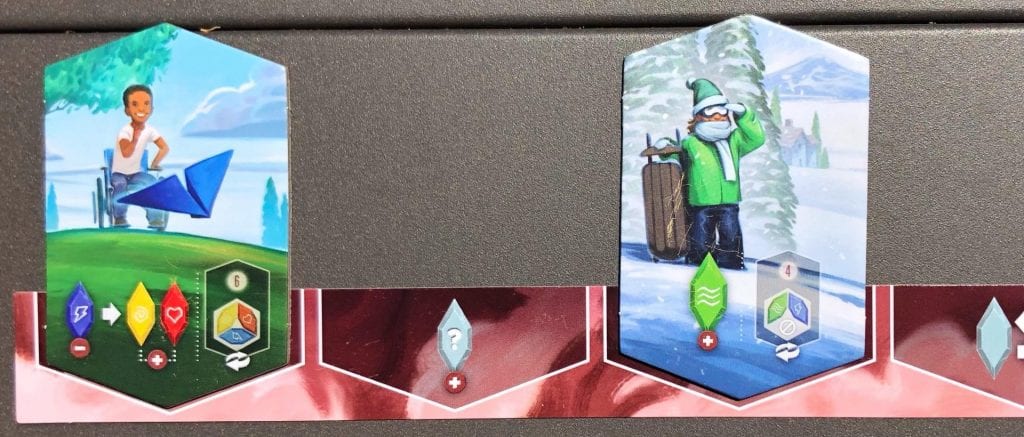
Any Moment tiles whose abilities were used get flipped to their scoring side. Once all players have taken or declined their available actions, they’ll score their board. Points are earned for a variety of placements and effective scoring is one of the trickiest parts of Vivid.
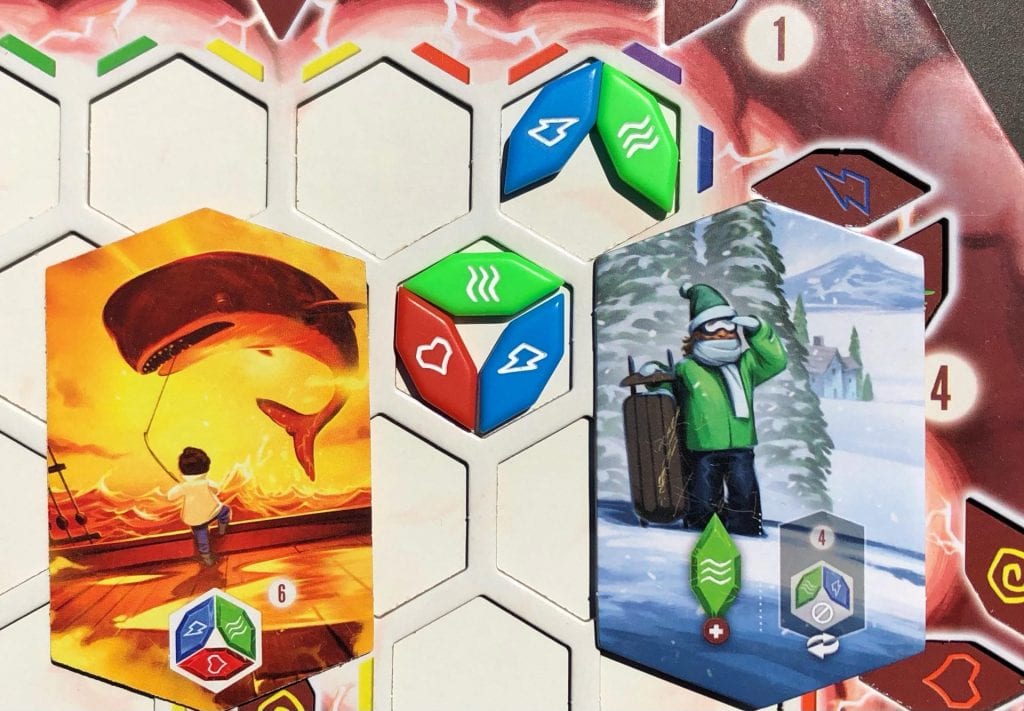
Players can score as follows:
- Each Moment has a scoring side which rewards players 4 points for a specific pair of colors in a hex (with no other Fragments) or 6 points for a specific trio of Fragments in a hex;
- Any line of same-colored Fragments that connect 2 or more empty Core Memory slots of that color scores the number of hexes multiplied by the number of slots, after which the slots are filled by the endmost Fragments in that line;
- Core Memories in which all slots are filled score according to their listed value, regardless of whether they were filled in that round or a previous one.

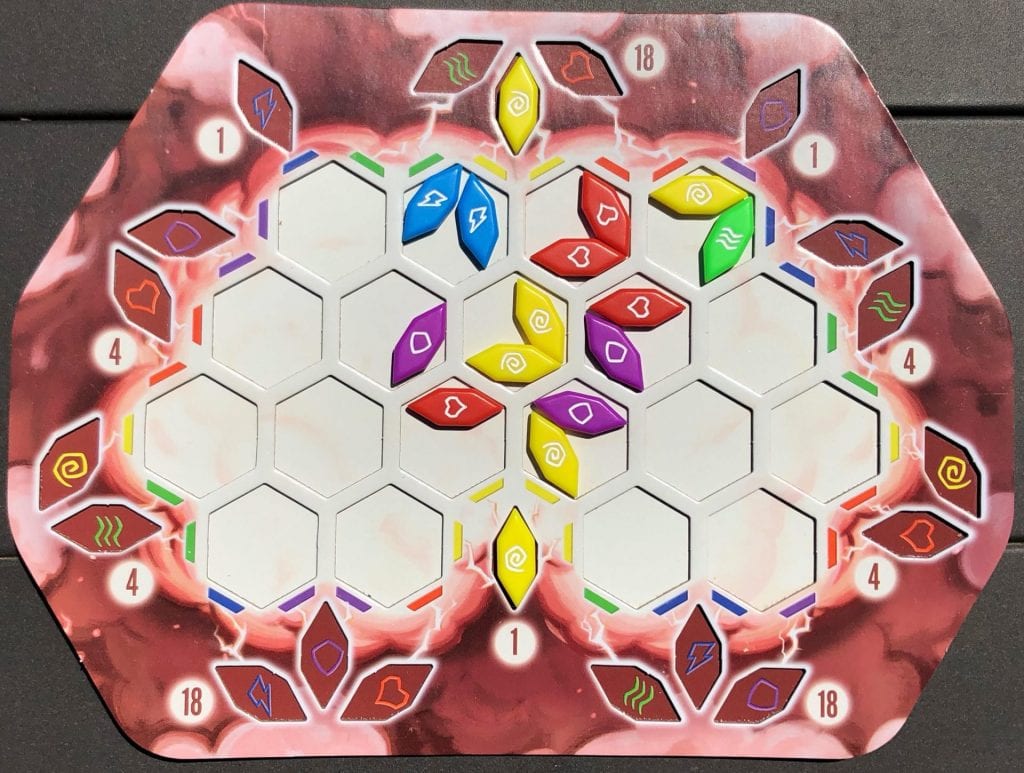
During the scoring phase of the 3rd round, players will also reveal and score their Aspiration tile. Each Aspiration shows a single color and the player will score 1 point for each placed Fragment of that color (or 2 points if the Fragment is in a Core Memory) as well as a whopping 5 points for each scored Moment tile that features that color.
Selective Memory
I’ll admit that it took me several plays to wrap my head around Vivid Memories and I’m still not sure I fully understand it. It’s not that the rules are particularly complicated, though there are a few important restrictions and conditions to memorize. (I’ve caught myself more than once placing drafted Fragments into a partially filled hex: a big no-no.)
Nor is it because Vivid Memories does something totally unfamiliar. It feels like a brain-burning positional puzzle in the tradition of Azul or Sagrada — also available from Floodgate Games — yet it also feels significantly more mentally taxing than either of those. The sheer number of permutations at play from moment to moment packs a lot of weight into a relatively short playtime.
There are many subtleties to a game of Vivid Memories and they all start from the draft. Players must be thoughtful about which arrangements of Fragments they want to take. There’s always a good reason to take a single Fragment (with its powerful board-manipulation ability) or grab a few to have the raw resources necessary to score. The Moment tiles can be a double-edged sword so it’s crucial to be careful about which ones you claim. And of course a skilled player will somehow simultaneously keep their eyes on their opponents to make sure that they’re not getting the Fragments they need for a particularly big score.
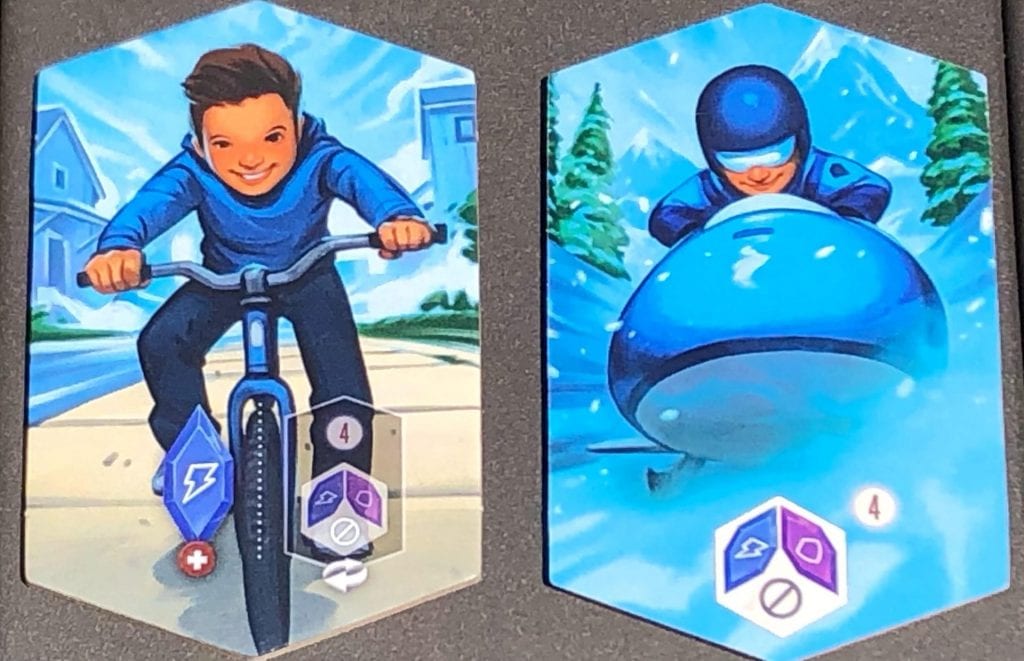
It’s a lot to think about, and what I find most difficult is visualizing how everything’s going to fall into place: which Moments I’ll be able to claim and where I’ll place them on my Memory Bank, which Fragments I’ll be able to add or swap and in which order, which Moments I’m going to score and which will hang around clogging up space, which Core Memories I can connect and whether it’s worthwhile to score now or wait until I can make a bigger chain between them, and so forth.
It’s all too easy to back myself into a corner by covering the wrong action or putting a Fragment in the wrong hex. Vivid Memories strongly rewards players who can think through the ramifications of each decision in their mind. For a game that’s nominally about remembering the past, there’s a lot of planning ahead to do.
That brings me to my least favorite part of Vivid Memories: its theme. There are many great abstracts whose workings are barely covered with the thinnest layer of theme. We’ve covered some of them in our reviews of the aforementioned Sagrada and Azul as well as Mandala (which shares a co-designer, Brett J. Gilbert, with Vivid Memories). I could list countless others.
Vivid Memories, however, is egregious in this regard. The theme itself is interesting; the execution is not. It leads to a lot of strange terminology that frankly interferes with a new player’s ability to learn the game. It’s much easier to understand “move Fragments in or out of this hex” than to imagine what “Rewiring” could possibly mean in the real world. Similarly, it’s difficult to explain that the Memory Bank board actually holds Moments while Core Memories are on the Brain board (and I intentionally glossed over the fact that scored Moments become Cherished Moments which don’t actually have a place on any board). If it wasn’t for the lush, charming art by Andrew Bosley I would have no problem discarding the theme entirely.

On a visual and tactile level, though, Vivid Memories works fairly well. The art on the Moment tiles is adorable and the shape of the tiles gives the game a distinct look. Each Fragment is double-coded with a color and a symbol and when seen together on the board they do have a striking effect. On a few occasions, I had trouble identifying possible scoring situations — with up to 3 multicolored Fragments in any given hex, it’s easy to skip over one that might be key to forming a thread or scoring a Moment tile.
Ultimately I keep coming back to the gameplay. At its core Vivid Memories really is a great game. There’s a lot to consider with each decision point and squeezing the most impactful plays into 3 brief rounds is a delightful challenge. Scoring can be pleasantly volatile, with players surging ahead in the final round as well-laid plans finally come to fruition (or fall apart completely). I may not feel like I’m creating a memory but I do feel like I’m solving an interesting puzzle with every game I play.
If you can forget the confusing theme and remember the important rules, Vivid Memories is an enjoyable title that will get every neuron firing without taking up a whole evening. So take a moment to back Vivid Memories on Kickstarter today!






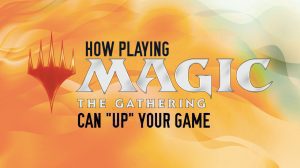




Add Comment